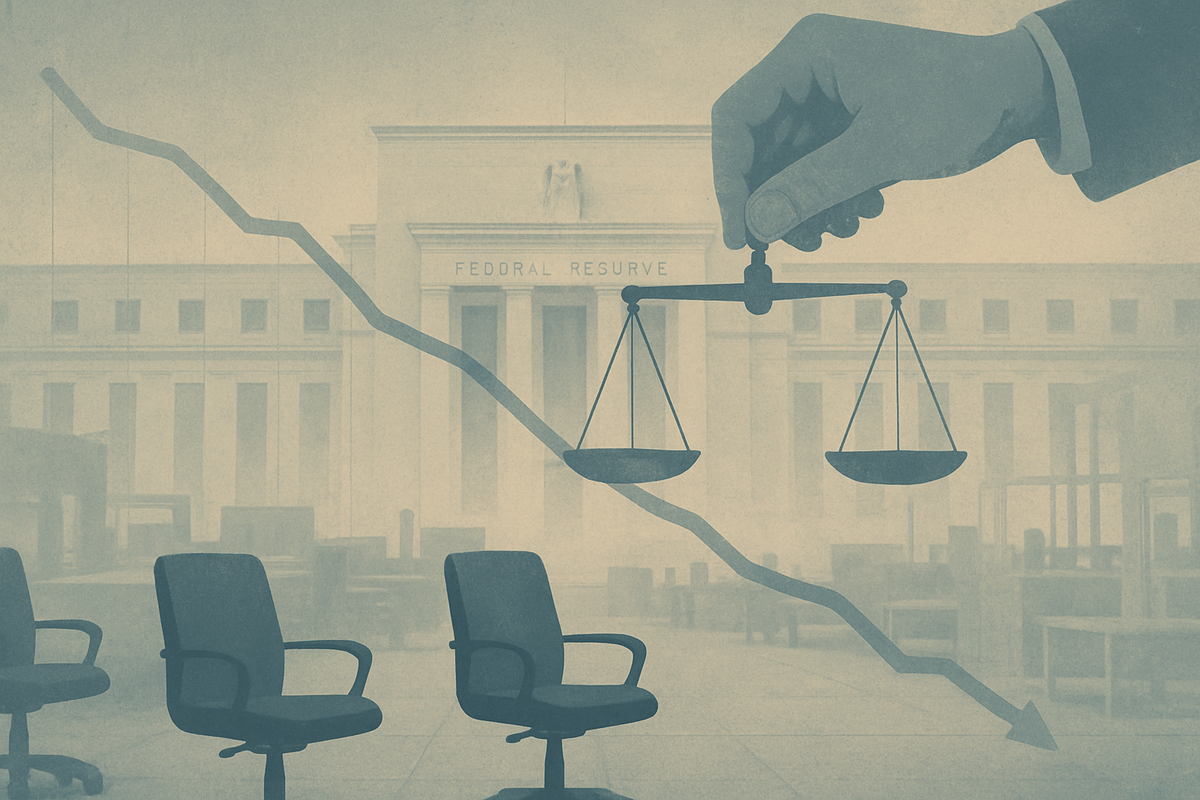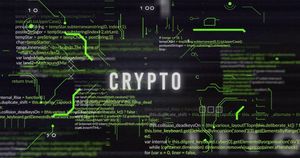Waller Sounds Alarm on 'Negative Job Growth,' Signaling Deeper Fed Cuts Ahead

Washington D.C. – October 10, 2025 – Federal Reserve Governor Christopher Waller delivered a stark warning today, Friday, October 10, 2025, sending ripples through financial markets with his assertion of "negative job growth" and a significantly stalling U.S. labor market. Speaking on CNBC's "Squawk Box," Waller’s remarks underscore a growing concern within the central bank regarding the health of the American workforce, and they strongly reinforce expectations for continued aggressive interest rate cuts in the near future. This pronouncement from a prominent Fed voice signals a potential pivot in the Fed's dual mandate focus, shifting greater attention to employment stability even as inflation remains a persistent, albeit complex, challenge.
Waller's comments are poised to solidify market sentiment around a dovish Federal Reserve, with investors now anticipating further reductions to the federal funds rate beyond the 25-basis-point cut implemented in September 2024. The urgency in his tone suggests that the Fed is prepared to act proactively to prevent a deeper downturn in employment, a move that could significantly reshape the economic landscape and the outlook for borrowing costs across the nation.
Waller's Dire Warning: A Labor Market in Retreat
Governor Christopher Waller's recent pronouncements have painted a concerning picture of the U.S. labor market, culminating in his unequivocal statement today, October 10, 2025, that "job growth has probably been negative for the last few months." This isn't an isolated observation but rather the latest in a series of warnings from Waller, who has consistently flagged the labor market as his "biggest concern." His August 28, 2025, speech had already cautioned that, after revisions, employment likely shrank over May, June, and July 2025, and in July, he characterized private-sector payroll growth as "near stall speed and flashing red."
The timing of Waller's latest remarks is particularly significant, as they come amidst a delayed official September jobs report due to a government shutdown. However, private data, such as ADP's report indicating a loss of 32,000 jobs in September, lends credence to Waller's pessimistic assessment. He further noted anecdotal evidence from business leaders who are not reporting "big hiring plans." This weakening labor market stands in stark contrast to robust Gross Domestic Product (GDP) growth and inflation that continues to exceed the Fed's 2% target. Waller emphasized this divergence, stating, "something's got to give. Either the labor market rebounds to match the GDP growth, or that GDP growth is going to pull back."
Waller's consistent advocacy for further interest rate cuts is rooted in this deteriorating labor market outlook. He supports additional quarter-point cuts at upcoming Federal Open Market Committee (FOMC) meetings, urging a cautious but steady approach to avoid policy missteps. The market is already pricing in a 25-basis-point cut at the October 29 FOMC meeting, with projections for a total of 100 basis points in reductions by the end of 2025. Waller believes that the effects of former President Trump's tariffs are temporary and that underlying inflation, excluding these impacts, remains close to target, thus justifying an easing of monetary policy to bring it closer to a "neutral" stance.
Shifting Fortunes: Winners and Losers in a Softening Economy
The confluence of a stalling labor market and the Federal Reserve's response of cautious interest rate cuts will undoubtedly create a complex environment, yielding both winners and losers across various public companies and sectors. As borrowing costs decrease, certain industries are poised to thrive, while others, particularly those reliant on robust consumer spending, face significant headwinds.
Technology companies, especially growth stocks and small-caps, are likely to be among the primary beneficiaries. Their reliance on external funding for research and development and expansion makes them highly sensitive to the cost of capital. Lower interest rates directly reduce their borrowing expenses, boosting valuations and fueling investment, particularly in the ongoing Artificial Intelligence (AI) boom. Similarly, the Real Estate and Homebuilding sectors are set for a significant boost. Reduced mortgage rates will enhance affordability, stimulating home sales and refinancing activity. Major homebuilders like D.R. Horton (NYSE: DHI), Lennar (NYSE: LEN), and PulteGroup (NYSE: PHM) stand to gain from increased demand and lower construction financing costs. Utilities, known for their stable dividend yields, also become more attractive to income-seeking investors as bond yields decline, while benefiting from cheaper financing for their capital-intensive projects. Consumer Staples companies, such as Procter & Gamble (NYSE: PG) or Coca-Cola (NYSE: KO), providing essential goods, are typically resilient during economic uncertainty, and lower financing costs can bolster their profit margins. Investment Banks with strong merger & acquisition (M&A) and underwriting divisions, like Goldman Sachs (NYSE: GS) or Morgan Stanley (NYSE: MS), could see increased fees as corporations pursue cheaper financing for deals and capital projects.
Conversely, sectors heavily dependent on robust consumer discretionary spending are likely to face considerable challenges. A stalling labor market directly impacts disposable income and consumer confidence, leading to cutbacks on non-essential purchases. Retailers, hospitality, and leisure industries, particularly those selling high-ticket items or luxury goods, will feel the pinch. Financial institutions, specifically local banks with high deposit costs, might experience pressure on their net interest margins (NIMs) as lending rates decline faster than deposit costs. Labor-intensive service industries, especially those seeing sharp declines in job openings, such as healthcare staffing agencies like AMN Healthcare (NYSE: AMN), could face reduced demand. Manufacturing, already showing signs of contracting employment and facing climbing raw material costs, will continue to navigate a difficult operating environment despite lower borrowing costs. Companies with limited pricing power in a market where consumers are increasingly value-conscious will also struggle to maintain profitability.
Broader Implications: Navigating the Fed's Dual Mandate Tightrope
Governor Waller's emphatic warning about negative job growth and a stalling labor market carries significant broader implications for the U.S. economy and the Federal Reserve's policy trajectory. This event underscores the inherent tension within the Fed's dual mandate: achieving maximum employment and maintaining price stability. While inflation has remained sticky, Waller's focus suggests a growing concern that the employment side of the mandate is under severe threat, potentially outweighing the immediate inflation battle in the Fed's hierarchy of concerns.
This shift fits into a broader trend of central banks globally grappling with post-pandemic economic complexities, where supply-side shocks and geopolitical events have made traditional monetary policy tools less predictable. Waller's dovish stance, advocating for proactive rate cuts, contrasts with more hawkish voices that might prioritize inflation containment above all else. His argument that the Fed should "look through" temporary tariff-induced price increases indicates a nuanced approach to inflation, distinguishing between transient shocks and underlying demand-driven pressures. This approach suggests a willingness to tolerate some near-term inflation if it means safeguarding the labor market from a more severe downturn.
Historically, the Fed has often found itself in a reactive position, cutting rates after significant economic deterioration. Waller's current advocacy for caution but consistent easing suggests an attempt to be more proactive, drawing lessons from past recessions where delayed action exacerbated economic pain. The divergence between strong GDP growth and a weak labor market presents a unique challenge, hinting at potential productivity gains not translating into job creation, or a significant lag in economic data. This situation could lead to regulatory or policy implications beyond interest rates, potentially prompting discussions about fiscal stimulus or targeted labor market interventions if the situation worsens. The ripple effects could extend to international markets, as a dovish Fed might encourage other central banks to consider similar easing, impacting global capital flows and currency valuations.
What Comes Next: A Path Towards Easing and Economic Rebalancing
The immediate aftermath of Governor Waller's latest warning will undoubtedly center on the Federal Open Market Committee (FOMC) meeting scheduled for October 29, 2025. A 25-basis-point interest rate cut is now not just anticipated but widely expected, solidifying the Fed's commitment to easing monetary policy in response to the deteriorating labor market. Looking further ahead, the market is already projecting a total of 100 basis points in rate reductions by the end of 2025, suggesting a sustained period of monetary accommodation.
In the short term, businesses and consumers can expect continued downward pressure on borrowing costs, which could stimulate investment and consumer spending, particularly in interest-rate-sensitive sectors like housing and durable goods. Companies may pivot their strategies to take advantage of cheaper capital, potentially accelerating mergers and acquisitions, capital expenditures, and stock buybacks. However, the true test will be whether these lower rates can effectively re-energize the stalling labor market, or if the underlying structural issues contributing to negative job growth persist.
Long-term possibilities include a gradual rebalancing of the economy, where lower rates help to stabilize employment without reigniting inflation significantly, especially if Waller's assessment of temporary tariff impacts proves correct. However, potential strategic adaptations will be required for companies operating in labor-intensive sectors, which may need to explore automation or efficiency improvements if the labor market remains constrained. Market opportunities may emerge in sectors that benefit from lower rates and defensive plays, while challenges will persist for highly cyclical industries and those exposed to the most vulnerable consumer segments. Potential scenarios range from a "soft landing" where the Fed successfully engineers a recovery in employment without a recession, to a more challenging environment if the labor market continues its decline, potentially forcing the Fed into more aggressive, even emergency, rate cuts.
A Pivotal Moment for the U.S. Economy
Governor Christopher Waller's repeated and increasingly urgent warnings about "negative job growth" mark a pivotal moment for the U.S. economy and the Federal Reserve's monetary policy. His statements, particularly today's on October 10, 2025, underscore a significant shift in the Fed's immediate priorities, with the health of the labor market now taking center stage amidst conflicting economic signals of strong GDP and persistent inflation. The key takeaway is clear: the Federal Reserve is committed to proactive easing to prevent a deeper downturn in employment, signaling a sustained period of lower interest rates.
Moving forward, the market will be keenly assessing the impact of these rate cuts on both the labor market and inflation. While lower borrowing costs are expected to provide a tailwind for growth-oriented sectors, real estate, and defensive industries, companies heavily reliant on broad-based consumer discretionary spending will face considerable headwinds. Investors should pay close attention to upcoming labor market reports, the Federal Reserve's communications, and any revisions to economic forecasts. The October 29 FOMC meeting will be crucial in confirming the Fed's dovish trajectory.
The significance of this event lies not only in the immediate policy response but also in its potential to reshape the economic landscape. If the Fed successfully navigates this complex environment, it could engineer a rebalancing where employment stabilizes without runaway inflation. However, the path is fraught with challenges, and the lasting impact will depend on the interplay between monetary policy, fiscal measures, and underlying economic resilience. Investors should watch for signs of stabilization in job growth, the trajectory of consumer spending, and the Fed's ongoing assessment of inflation, adjusting their portfolios to account for a lower-rate environment and the evolving fortunes of different sectors.
This content is intended for informational purposes only and is not financial advice
More News
View More




Recent Quotes
View More
Quotes delayed at least 20 minutes.
By accessing this page, you agree to the Privacy Policy and Terms Of Service.